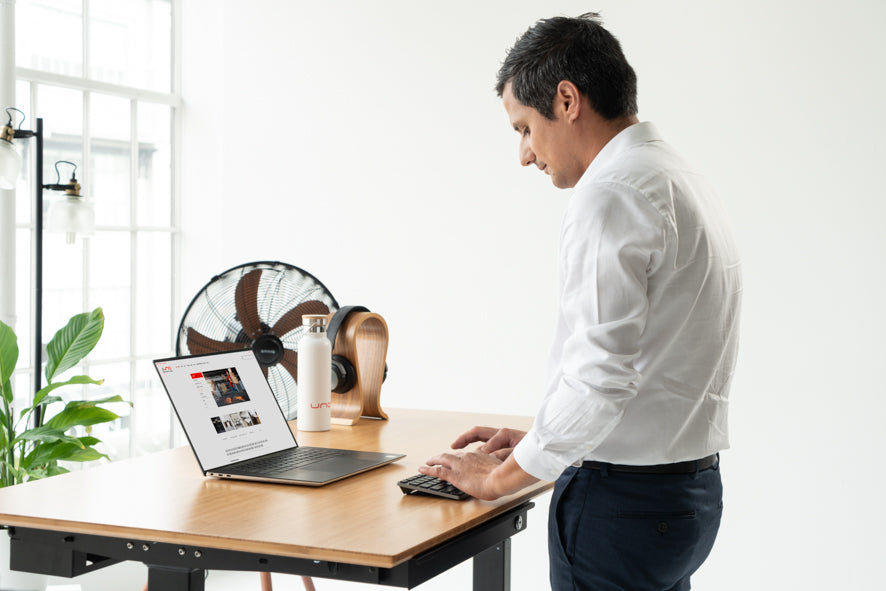Using a desk you can stand at, rather than having to sit all day, has become increasingly popular. There are two very good reasons for this; it’s better for your health and you tend to get more done.
Gaining the benefits of a stand up desk and avoiding potential health problems relies on using it correctly. So here are some of the main things to get right.
Ergonomic adjustment is still important for a standing desk
To maximise comfort and minimise the risk of injury, it’s important to have the right standing desk set-up for each person – just like it always has been for standard desks and chairs.
The main things to focus on are the correct desk height and where your computer screen is. Since there’s no chair height to adjust, you need a height adjustable desk.
When standing, your elbows should just brush over the desk top as you turn. The goal is to have your forearm parallel to the floor and at right angles to your upper arm.
It’s generally accepted that your screen should be about 50 to 70 cm from your eyes. As a rough guide, if you put your elbow in line with the edge of the desk, your finger tips should just reach the screen.
The top of the screen should be at eye level and angled slightly back. If you’re working on a laptop, it’s best to put it on a raised platform and use a separate keyboard or use it with a separate screen. This also applies to sitting desks, of course. The eye level set-up is designed to ensure your head is not tilted for long periods as you work.
Footwear and floor surface become important
People who work on their feet for most of the day, such as nurses and retail workers, understand the importance of wearing supportive footwear. That usually means a wide stable sole, low heel, good arch support for your foot shape and room to wiggle your toes.
The floor surface is also important, so anti fatigue mats are recommended for roles that involve lots of standing, such as counter service or manufacturing. The mats help blood flow and improve comfort by encouraging your leg muscles to make frequent micro-movements. Anti fatigue mats have been shown to be beneficial for people who stand for more than two hours a day, which includes most stand up desk users. See our anti fatigue mat.
Wrist angle should be slightly different at a standing desk
When standing, it’s still important to have your keyboard and mouse at the same level. Your wrists should be straight when using the keyboard, so tilted slightly more upward (extended) than when sitting.
A mouse pad with a gel wrist-rest, adjustable keyboard stand or the negative tilt tray which clips onto the front of the desk, but hangs under it) ) are worth considering if you still have sore wrists sometimes.
Alternating between sitting and standing is the key
Dr James Levine from the Mayo Clinic famously claimed that ‘sitting is the new smoking, kills high number of people and is more dangerous than parachuting’. He wasn’t just referring to our workplaces, but our lives in general.
While the comparison to smoking has been refuted by some researchers, they still agree that sitting for more than eight hours a day in total increases your risk of suffering some chronic diseases and an early death by up to 20%. [1]
Although sitting too much is clearly not good for you, neither is standing for long periods. People who work in standing occupations are more prone to lower back pain. It’s also thought to have a negative impact on tendons and muscles, and may lead to varicose veins.
The answer is to regularly switch between sitting and standing, as well as taking micro-breaks away from your desk.
Early research suggests you should spend an hour standing for every one to two hours of sitting at work. It’s also best to avoid standing for more than 60 minutes at a time. Some people find it easier to spend a bit more time standing in the morning and a little less in the afternoon, when they might feel more tired.
As an aside, if you’re in meetings for much of the day, you might like to try the odd stand up meeting. It can be surprising how efficient meetings become when everyone is standing in a circle rather than relaxing in comfy chairs.
What is the best adjustable standing desk?
The importance of regularly switching between sitting and standing means the best standing desk is usually an electric one. They’re much easier to adjust to exactly the right height than those with a manual winding handle. And when it’s easy to adjust, you’ll do it more often and with more precision. Both of which are better for you.
See our range of adjustable standing desks.
[1] Source: https://www.sciencedaily.com/releases/2018/11/181105105419.htm
